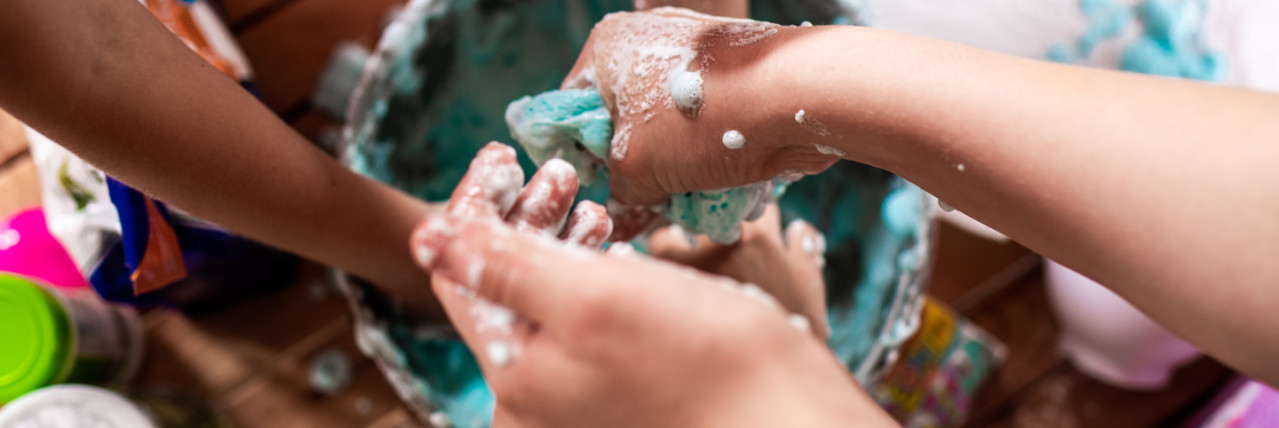When it comes to having fun, exploring their surroundings, and learning through their experiences, children need to get dirty. There’s so much more to dirt than the stains and effort it’s going to take to do the laundry. The stains are a result of messy play which aids children’s development and helps them learn through play.
Let’s look at some of the ways that messy play is so critical to childhood development along with examples of how you can facilitate it:
Fine Motor Skills
Fine Motor Skills are associated with smaller movements in the fingers, toes, wrists, ankles, hands and feet and involve more dextrous actions such as grasping, pinching, picking, writing and even blinking.
Activities such as creating origami and playing hide and seek with objects are great for developing this type of skill. Create your own sensory bin by taking a tub or a large container and filling it with materials and objects to stimulate the five senses; examples of favourite fillers include edible mud, water beads, or jelly. Then, make a list, and let your kids find tiny objects among the different textures such as small objects, shapes, their favourite toy. You can up the stakes by awarding points for each object and prizes for certain point milestones.
Gross Motor Skills
Children that are getting dirty are active children, which is excellent news for their physical health. Actions such as balancing on a log, climbing a tree or playing soccer – are part of the development of large motor skills which include coordination, balance, stability and spatial orientation.
From the time in the sandpit to the sprinkler activities that require the use of large muscle groups for running, jumping, lifting and manoeuvring bigger objects, these activities target your little ones’ large motor development.
Give yard twister a try or encourage your little ones to create and run through an obstacle course using what they can find around the garden. Create muddy puddles to jump over and leopard crawl through for added mess-factor, and fun of course.
Worried about the dirt and mud stains, that will come with the messy play? Don’t, they’re no match for OMO.
Social and Emotional Skills
Kids who engage in messy play are more likely to talk to other kids, invent new games together and bond over their shared fun. These interactions are brilliant for developing their social skills and for building up their confidence.
When children play hide-and-seek, team sports, or any group game – they are learning about developing relationships and social awareness. Any activity that involves expression is great for emotional development, which is why art is such a fantastic medium for development.
Getting messy while creating art is an excellent way for your little ones to learn. Choose to use washable paints and encourage your little one to paint faces or pictures that express as many emotions as they can think of. You can get involved too, it’s a great time to explore creativity with your little ones and it's perfect for bonding too.
Cognitive Development
Cognitive development is how children think, explore and problem solve. As they develop understanding, skills, figure things out and evolve their character, they learn to think about and understand the world around them.
Activities like crafts help to exercise kids’ creativity and self-expression - so encourage the creation of taste safe mud and let them enjoy hours of playing in a tasty puddle. Alternatively, head outside for some real muddy fun with a game of stuck-in-the-mud to help them learn real-life skills such as planning and strategy.
Speech and Language Development
Speech and language support your child’s ability to communicate, express and understand the world around them. It’s how we as human beings, express ourselves and it’s an important and fundamental part of development.
Games such as “Name It” or “What’s That Colour?” encourage your little ones to explore their language abilities. These games can be played in conjunction with many of the other messy play activities too. Simply ask your child to name each new thing they touch or to say what it is or what colour each new object they touch is.
As parents, we want what’s best for our children. One of the best things that we can do is to aid their development with the benefits and exciting experiences of messy play. Encourage your kids to get outdoors more often and cultivate a family environment where kids know that it’s okay to get their clothes dirty.
Messy Play Tools
Here are some tools for messy play activities that you can find at home which are perfect for filling sensory bins or just to encourage your kids to explore. Create textural landscapes, build wonderlands together or invent an outdoor game with these tools and your imagination.
Shaving cream
Use it to create exciting textures, or as the perfect topping for mud pies, the options are endless.
Coloured rice, pasta and other grains
Perfect for creating landscapes while crafting or in a hide and find box loaded with treasures.
Jelly
Jelly seems to have a life of its own, it can be used to float interesting objects or can be set to different consistencies for some textural variety – opt for thin and slimy or thick and wobbly. Use jelly to create a landscape of edible wonders or squish it up as a great filler in a sensory bin.
Pompoms or cotton balls
Brightly coloured, different sizes and for all manner of arts and crafts, when it comes to pom poms and cotton balls the more, the merrier.
Coloured salt
Salt can be tinted blue and transformed into an ocean or tinted red and made into lava, not to mention it comes in differing sizes from fine and flaked to coarse and even rock perfect for any number of sensory experiences.
Washable paint
Paint paving stones, floors and walls only to reset the space with the wipe of a cloth.
Other great fillers for sensory bins or for games and crafts include:
Tinsel
Crazy sand
Streamers
Packing peanuts
Clay
Shredded paper
Water
Desiccated coconut – tinted with different colours
Leaves
Frozen shapes – can be tinted and flavoured
Rocks
Bubble wrap
Granola
Tissue paper
Water beads
Different types of soap
Shaving cream puffy paint
Shakers
Sand foam
Bubbling cloud dough
Scented cloud dough – add scents to the dough
Textured cloud dough - add little foam beads/styrene balls to the dough
Glitter cloud dough - add glitter to the dough
Foam bead slime- add foam beads to our slime recipe
Sensory snow/Fake snow
OMO has worked with experiential play and child development experts to develop a bank of messy indoor and outdoor activities for kids that promote both development and fun.
It’s time to let our children play freely without fear of dirt - leave the stain removal to OMO.


